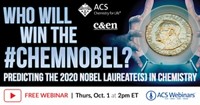Advertisement
Grab your lab coat. Let's get started
Welcome!
Welcome!
Create an account below to get 6 C&EN articles per month, receive newsletters and more - all free.
It seems this is your first time logging in online. Please enter the following information to continue.
As an ACS member you automatically get access to this site. All we need is few more details to create your reading experience.
Not you? Sign in with a different account.
Not you? Sign in with a different account.
ERROR 1
ERROR 1
ERROR 2
ERROR 2
ERROR 2
ERROR 2
ERROR 2
Password and Confirm password must match.
If you have an ACS member number, please enter it here so we can link this account to your membership. (optional)
ERROR 2
ACS values your privacy. By submitting your information, you are gaining access to C&EN and subscribing to our weekly newsletter. We use the information you provide to make your reading experience better, and we will never sell your data to third party members.
Profiles
CRISPR pioneer Jennifer Doudna shares her outlook for the groundbreaking gene-editing tool
UC Berkeley biochemist discusses how CRISPR could affect chemistry in areas including drug discovery and agriculture
by Melissa Pandika, special to C&EN
April 18, 2017
| A version of this story appeared in
Volume 95, Issue 17
It’s been less than five years since University of California, Berkeley, biochemist Jennifer Doudna and colleagues unveiled the gene-editing tool CRISPR in Science (2012, DOI: 10.1126/science.1225829), but its use among researchers across the globe has already exploded.
Last April, for example, Sichuan University scientists announced that they had used CRISPR to program T cells from the immune system of a person with lung cancer to kill tumor cells (Nature 2016, DOI: 10.1038/nature.2016.20988). And late last year, a UC Berkeley team reported harnessing the technology to correct the genetic mutation responsible for sickle cell anemia in stem cells from patients with the disease (Sci. Transl. Med. 2016, DOI: 10.1126/scitranslmed.aaf9336).
Doudna didn’t set out to develop a far-reaching gene-editing tool years ago. Initially, her team wanted to uncover the role of CRISPRs—short for “clustered regularly interspaced short palindromic repeats”—which are repetitive sequences of RNA hidden in the genomes of many bacteria.
Eventually, Doudna; Emmanuelle Charpentier, now the director of the Max Planck Institute for Infection Biology; and coworkers discovered that CRISPRs help bacteria fight viral infection. Bacteria snag bits of an invading virus’s RNA and tuck them into CRISPRs, the team found. If the virus strikes again, these modified CRISPRs bind to the pathogen’s DNA, signaling to the enzyme Cas9 to come and dice up the foreign genetic material. The researchers realized they could harness this machinery to cut and paste target DNA fragments at will, as long as they introduced the appropriate designer RNA sequences.
Vitals
▸ Hometown: Hilo, Hawaii
▸ Education: B.A., biochemistry, Pomona College, 1985; Ph.D., biological chemistry and molecular pharmacology, Harvard Medical School, 1989
▸ Current positions: professor, department of molecular and cell biology and department of chemistry at UC Berkeley; director, Innovative Genomics Initiative at UC Berkeley/UC San Francisco; investigator, Howard Hughes Medical Institute
▸ Inspiration for cracking the CRISPR code: My dad was not a scientist, but he loved solving puzzles. One of his favorites was cryptoquotes—quotes by famous people that are encrypted. The challenge is to break the code and solve the quote. They would come out in our local newspaper, and when my dad got stuck, he would often enlist help from family members, including me. It really taught me about the joy of finding things out. With cryptoquotes, it’s a bit like science; you have a hypothesis about what the code is, and you test it. That was my first exposure to the idea of setting up experiments.
▸ Favorite bacterium: Can I pick two? The first is Escherichia coli, the workhorse of molecular biology. The other is a group of bugs called the candidate phyla radiation, discovered by Jill Banfield, a biogeochemist and geomicrobiologist at UC Berkeley. These are tiny bacteria with only 50 ribosomes to make proteins [most bacteria contain tens of thousands of ribosomes] and super-small genomes. Yet some of them have CRISPRs. We’d like to understand why they do and what that might mean for the interesting properties that enable these bacteria to survive in groundwater, soil, and dairy farms.
What started as a small project “aimed at something seemingly unrelated … led to a very different direction,” Doudna said during the Kavli keynote address on April 3 at the ACS national meeting in San Francisco. C&EN caught up with Doudna at the meeting to discuss the importance of curiosity-driven basic research and her outlook for CRISPR.
How do you think CRISPR will impact chemistry, including how chemists conduct research?
The convergence of chemistry with other disciplines to tackle interesting problems in science is exciting. More and more, I see chemists using gene editing to make precise changes to molecules, such as proteins. That allows them to connect discoveries made using purified biomolecules outside cells—enzymes reacting in lab vessels, for instance—to what you would find in a living organism. That’s really amazing. With better chemical understanding of the way these enzymes operate, it will be possible to use them in ways that they don’t seem to be deploying in nature.
The ability to make changes to the DNA of plant cells also opens up opportunities both in research and in solving problems in agriculture. That includes helping plants defend themselves against infection, drought, and other climate-change-related issues from a chemical perspective. With CRISPR, you understand the precise changes that you’re making to DNA—at the level of individual base pairs—rather than randomly introducing changes by exposing plant seeds to chemicals that cause DNA mutations.
In drug discovery, one of the big challenges for chemists is determining the targets of small molecules. Now, you can potentially very rapidly figure out the targets by using CRISPR to query cells on a genomewide scale. You can disrupt certain genes and then ask if cells are still susceptible to the small molecules. I’m excited about that as an important research application but also as a practical way of doing drug discovery.
Most CRISPR work has so far been carried out in the lab. What real-world applications of CRISPR can we expect to see first?
We can do gene editing on cells ex vivo—meaning outside the organism—and the edited cells can then be reintroduced to the body, which gets around the challenge of drug delivery. For clinical use, we’ll probably see treatments like this that involve immune cells in the blood first, since they can be collected outside the body.
In agriculture, we’ve already begun seeing products that have been created using precision gene editing. That brings up a bunch of regulatory challenges. The U.S. Department of Agriculture has decided that plant products created using CRISPR that don’t introduce foreign DNA are not considered genetically modified, which has led to lots of discussion. In other countries, the regulation of GMO plants is different, so I think people are being pushed to reevaluate how these are defined based on the opportunities we now have with CRISPR.
What improvements would you like to see made to the technology?
Where we’ll likely see advancements being made is in deploying CRISPR to do more specific kinds of things. One is using it not to cleave DNA directly but to make a direct chemical modification to DNA, whether it’s changing one nucleotide base into another one or adding a methyl group.
What ethical issues will researchers need to consider in their applications of CRISPR?
CRISPR has made possible genetic changes in individual organisms and even made it possible to pass along changes to offspring. This raises ethical concerns, particularly regarding human embryo or germ-line editing that might lead to permanent changes in the DNA that can be passed on to future generations. I’ve been actively involved in discussing these issues. As scientists, we need to explain what we’re doing and why we’re doing it, not dictating how these discoveries and technologies should be used. We need to participate in those conversations with the public. This is important, especially now, when there’s a lot of questioning about scientific knowledge, the value of facts, and how scientific data are used to help governments make decisions about regulations and funding.
In February, the U.S. Patent & Trademark Office upheld patents awarded to the Broad Institute of Massachusetts Institute of Technology and Harvard University for the use of CRISPR in eukaryotic cells. About a month later, the European Patent Office announced plans to award a patent to the University of California that covers a wide range of CRISPR uses. How do you see the patent battle playing out in the years ahead?
Patents around important technologies typically are complicated. It takes a while to sort them out, and CRISPR is no different. Honestly, I think it will take a while before the patent situation is resolved in different countries. The exciting thing for me is that we’re seeing rapid deployment of the CRISPR technology both in academic settings and in companies. That’s leading to real advances for various diseases. There are exciting uses in agriculture and in fundamental research. None of that is being hampered by the current patent situation.
CORRECTION: This Q&A was updated on April 21, 2017, to correct the affiliation of the team that used CRISPR to fix the genetic mutation responsible for sickle cell anemia in patients’ stem cells. It is UC Berkeley, not Stanford.
Melissa Pandika is a freelance science writer in Berkeley, Calif. This interview was edited for length and clarity.






Join the conversation
Contact the reporter
Submit a Letter to the Editor for publication
Engage with us on Twitter